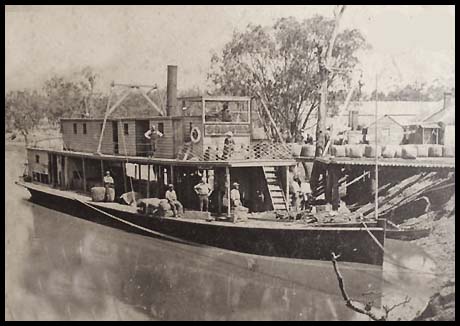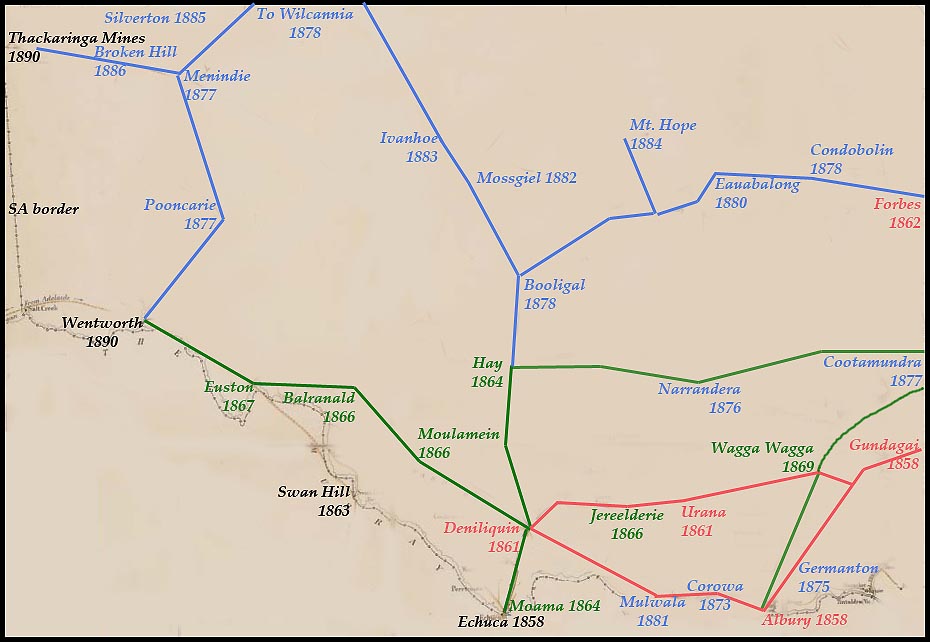Lines in the South-West region.
- Home, index, site details
- Australia 1901-1988
- New South Wales
- Overview of NSW
- Telegraph lines
- Telegraph Offices
- Date stamps
- Forms
- Envelopes
- Rates
- Stamps
- Queensland
- Overview of Qld
- Telegraph lines
- Telegraph offices
- Date stamps
- Forms
- Envelopes
- Rates
- Stamps
- South Australia
- Overview of SA
- Telegraph lines
- Telegraph Offices
- Date stamps
- Forms
- Envelopes
- Rates
- Stamps
- Tasmania
- Overview of Tasmania
- General developments
- Reports
- Organisation
- Telegraph lines
- Telegraph Offices
- Date stamps
- Railway lines
- Forms
- Envelopes
- Rates
- Stamps
- Overview of Tasmania
- Victoria
- Overview of Vic.
- Telegraph lines
- Telegraph offices
- Date stamps
- Forms
- Envelopes
- Rates
- Stamps
- Ephemera
- Western Australia
- Overview of WA
- Telegraph lines
- Telegraph Offices
- Date stamps
- Forms
- Envelopes
- Rates
- Stamps
The south-west region of New South Wales is defined in this site as being bounded by the first line from Sydney to Albury, the Victorian border, the South Australia and south of (and excluding) Broken Hill.
The map of the region below shows the main Telegraph lines and the Telegraph Offices opened to about 1880. The top of the map joins to the north-west region while the right of the map joins to the south-east region.
The colours used for the telegraph lines on the map indicate the broad time periods with details of developments provided below:
|
The first line south to the Victorian border is shown in pink at the far right linking Gundagai to Albury in 1858.
After a couple of years, it was considered desirable to duplicate the line to Victoria in the same way as the lines between Victoria and South Australia were being duplicated. Telegraph lines had been constructed by the Victorian Electric Telegraph Department in this region from 1858.
On 7 September 1859, the Sydney Morning Herald noted that there was a sum placed on the forward Estimates "for constructing a line from Gundagai to Deniliquin, connecting there with the line passing through Echuca, Sandhurst and Castlemaine to Melbourne. This line would afford us a duplicate route to Melbourne and will be useful when the line between Melbourne and Albury is broken down - as it usually is about once a week - somewhere in the neighbourhood of Wangaratta. A cross-country line runs from Castlemaine to Ballaarat, connecting there with the Western line of Victoria which runs to Portland and the South Australian frontier. By passing messages from Sydney to Adelaide via Gundagai, Deniliquin, Castlemaine and Ballaarat, it will be possible therefore to avoid Melbourne; but at Ballaarat the traffic to the west all converges on the line - at present a single one - which stretches from there to the South Australian boundary, and this line is overworked under the pressure of English mail advices, having to forward all that is due to Melbourne and to Sydney, as well as to all the intermediate towns".
Hence, to commence this strategy, a line was constructed from Albury to Deniliquin which was located just above Echuca in the central-north region of Victoria. Then a 51 mile line was constructed from Deniliquin south to Moama by a private company called the Deniliquin Telegraph Company. The line was purchased by the Government on 1 August 1861 at a cost of £2,820/8/- giving the company a 10% profit.
Deniliquin was also linked via Urana to the main line somewhere south of Gundagai at a now unknown repeater station giving "two distinct routes between Gundagai and Melbourne, a result which has proved of great advantage when interruptions have occurred on the direct line via Albury" (Superintendent of Telegraphs (Cracknell) Report for 1861). McGowan, in his 1864 Report (p. 4) agreed as follows:
"The interior circuit via Echuca, Deniliquin, Wagga Wagga &c is found to be peculiarly valuable in connection with the intercolonial (New South Wales) business, at times when the direct line may be interrupted at any part of the route, and conversely a similar advantage is secured when a break occurs on the northern or interior line".
The priority for line construction was to extend the lines to the west along the border with Victoria. In part this policy was looking towards a direct telegraphic link with South Australia but also in part to meet the needs of areas which were important for inter-colonial traffic.
The first lines constructed in this period were however south from Deniliquin to Moama to meet with the Victorian line at Echua. This link was made in 1864 - the same year as Echuca was linked by the railway to Melbourne - and provided a second telegraphic link between the two Colonies.
The other construction in 1864 was from Deniliquin north to Hay - located about mid-way between Sydney and Adelaide. Only three years previously, the old name of Lang's Crossing Place was changed to Hay. It was an important town in the area being the crossing on the Murrumbidgee River of “the Great North Road” - a major stock-route. It was also connected by the river to Gundagai. By 1860, steamers were travelling up the Murrumbidgee to Lang's Crossing Place - with some going on to Gundagai.
Further work continued from Deniliquin in 1866 to the north-east below the Hay line. The early route east to Urana incorporated a new telegraph station at Jereelderie - which was changed to Jerilderie in February 1890. It was in February 1879 that Ned Kelly and his Gang wanted to rob the Bank of New South Wales in Jerilderie and, while there, inflicted extensive damage to the Telegraph Office.
With all of these lines coming through Deniliquin, the role of the Telegraph Office was expanded to encompass duties as a "repeater station". Consequently an assistant operator was appointed there, the work being too much for one person. The centre of the pastoral districts of New South Wales then had a line of telegraph through it. The Pastoral Times was able to publish news in forty-eight hours from "Fort Bourke" and, as a line was soon made to the latter point - namely to the head of the Darling River, residents around Deniliquin were able to receive daily news from Bourke.
The telegraph line was also extended west to Moulamein and Balranald (1866) and then to Euston (26 April 1867) and Wentworth. The 1861 budget for this extension was £25,000. Balranald was the end of a mail line which ran to Wagga Wagga as well as being a main crossing point over the Murrumbidgee for stock from South Australia. Euston was a similar crossing place for the Murray River. The three stations were conveniently located although the main reason for the line being extended was to reach the last location in New South Wales before the South Australian border - Wentworth.
Wentworth is located at the junction of the Darling and Murray rivers and is about 100 kms from the South Australian border. There was no need for a telegraph station to be opened there and a repeater station was adequate for all purposes until 1890. There were, however, two critically important reasons for the line being extended to Wentworth from Deniliquin:
- it provided the best route along which to construct the first direct line between New South Wales and South Australia. The route was via Wentworth to Blanche Town.
- in the mid-1860s, the location of the border (especially between Victoria and South Australia along the 141st east meridian) was uncertain and was the subject of investigation by Charles Todd in 1867. The line through to Wentworth assisted Todd to link telegraphically to both Sydney and Melbourne via Deniliquin (and via Echuca to Melbourne) for his measurements.
After 1867, there was then a 5-6 year pause in major construction activity in the south-west region.
The first major activity in the region after 1867 was the extension of the line from Albury to Corowa where the Telegraph Office was opened in January 1873. As Corowa is n the opposite side on the Murray River from Wahgunyah, the opening of the Corowa Telegraph Office enabled an alternative connection from Sydney via Albury and Corowa/Wahgunyah to Melbourne.
Later in 1873, a Telegraph Office was opened on the main telegraph line north of Albury at Ten Mile Creek. In 1875, the office changed its name to Germanton but changed its name again during World War 1 (in 1915) to Holbrook.
About 1876, after construction activity in other regions of the Colony had been completed and various intermediate telegraph offices had been opened, priority shifted to opening up the western region of the Colony.
Three parallel lines to the south-west were constructed starting in 1873:
- from Albury through Corowa to Deniliquin (1873) with a Telegraph Office opened at Mulwala in 1881;
- from Yass to Murrumburrah (in the south-east region) and then on to Cootamundra and Hay.
- from Forbes (after a pause of 16 years) to Condobolin and Booligal (1878). Soon after the line linked Booligal south to Hay.
| Corowa (NSW) was on the opposite bank of the Murray River from Wahgunya (Vic). There were a number of such "twin town" arrangements. Albury-Wodonga was an important connection. Another further down the Murray was at Echuca (Vic) - Moama (NSW) just below Deniliquin.
The River was also a critically important mode of communication for the settlers all along its banks. It was used to transport all goods up and down. The picture (at the right) shows a typical boat which plied its trade - here carrying wool bales as can be seen stacked on the Corowa wharf. |
 Typical river transport loading wool bales from the wharf (in the background) at Corowa about 1906. |
About the same time, the major telegraph line in the far west of New South Wales was commenced. It ran north through Pooncarie and Menindie (1877) and on to Wilcannia (1878) and Bourke (1873) in the north-west region. This major construction activity - carried out in the most trying conditions - provided a complete circuit around New South Wales.
Both Pooncarie and Menindie were strategically located places:
- Pooncarie had been the centre for illegal grazing by European settlers since the 1840s and the Colonial Government had made efforts to control the region during the 1860s. It was situated on the banks of the Darling River and so was a port for paddle-steamers - especially for the transport of wool from western NSW to Southern Queensland and South Australia. Its location also attracted Burke and Wills on their ill-fated expedition when they made their 30th camp just south of Pooncarie (at Tarcola) on 26 September 1860. From there, they headed north to Menindee on 11 October.
- Menindee was the first town to be established on the Darling River. Early visitors included a sample from the "Whos-Who" of Australian explorers -Thomas Mitchell (1835), Charles Sturt (1844) and Burke and Wills (1860). Before 1877, there was nothing to the west.
Menindee is about 110 km south-east from the Broken Hill area where, in 1867, a rumour was started about a gold find at Thackaringa. In 1877, a rich silver lode was discovered but the assay sample went missing en route to England. By 1880, prospectors began to explore the area west of Menindee. To the north, Silverton was established in 1885 and the telegraph line was extended from Menindee. The Silverton telegraph office was opened in August 1885. Broken Hill was established in 1883 with the telegraph office opening in 1886. A telegraph office at Thackaringa Mines was opened in 1889.
